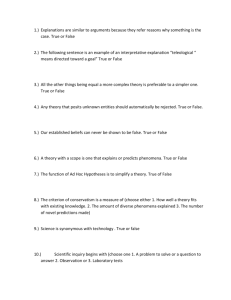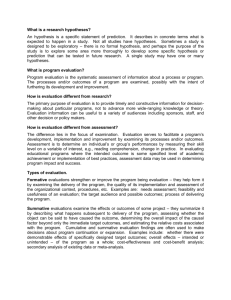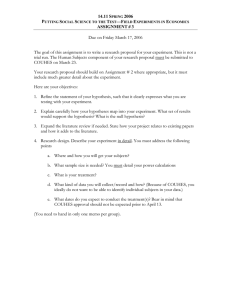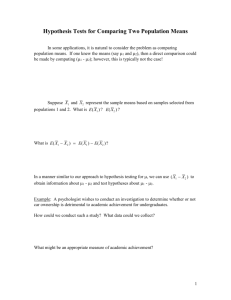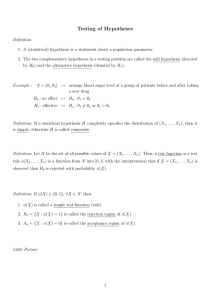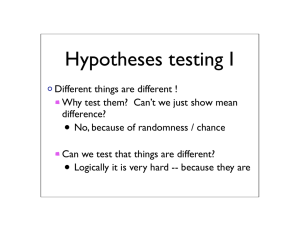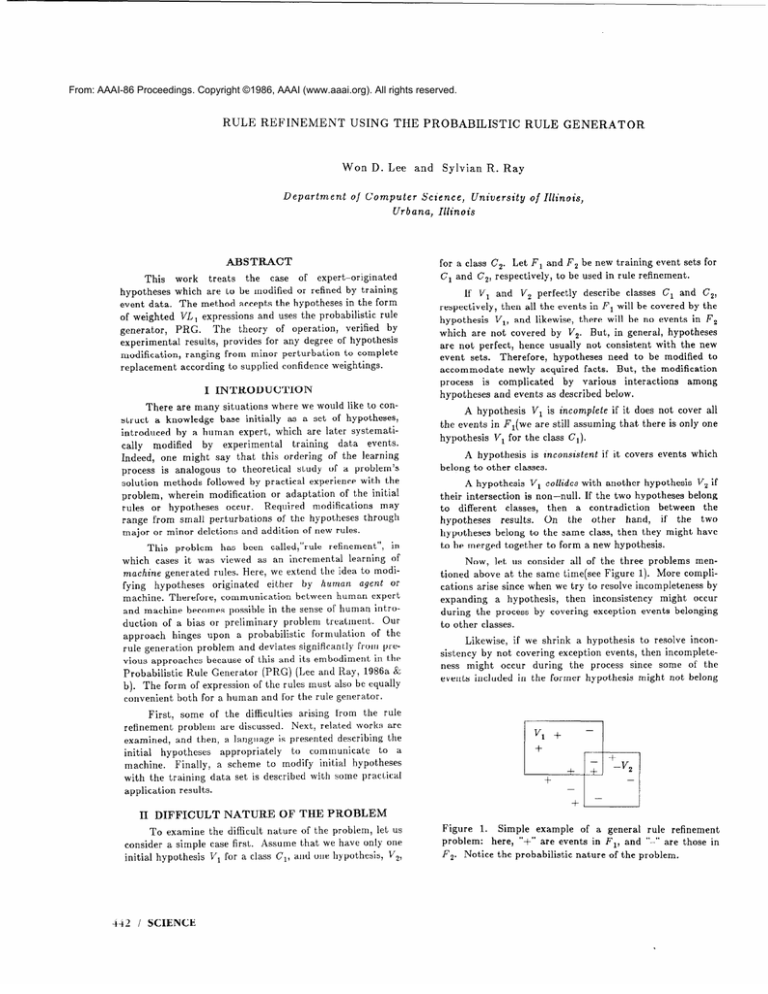
From: AAAI-86 Proceedings. Copyright ©1986, AAAI (www.aaai.org). All rights reserved.
RULE REFINEMENT
USING
Won
Department
THE PROBABILISTIC
D. Lee
of Computer
and
Science,
Urbana,
ABSTRACT
work
treats
the
case
of expert-originated
which are to be modified or refined by training
The method accepts the hypotheses
in the form
VL, expressions
and uses the probabilistic
rule
generator,
experimental
modification,
replacement
PRG.
The theory
of operation,
verified
by
results,
provides
for any degree of hypothesis
ranging
from minor perturbation
to complete
according
to supplied confidence weightings.
I INTRODUCTION
are many
situations
where
we would
from small perturbations
of the hypotheses
or minor deletions
and addition
of new rules.
through
This problem
has been called,“rule
refinement”,
in
which
cases it was viewed as an incremental
learning
of
machine generated
rules. Here, we extend the idea to modifying
hypotheses
originated
either
by human agent or
machine.
Therefore,
communication
between human expert
and machine
becomes possible in the sense of human introduction
of a bias or preliminary
problem
treatment.
Our
formulation
of the
approach
hinges
upon a probabilistic
rule generation
problem
and deviates significantly
from previous approaches
because of this and its embodiment
in the
Probabilistic
Rule Generator
(PRG) (Lee and Ray, 1986a &
b). The form of expression
of the rules must also be equally
convenient
both for a human and for the rule generator.
First,
some
of the
difficulties
arising
from
the
the
application
training
data
set is described
with
some
Ray
University
C, and
of Illinois,
If
C,.
Let F, and F, be new training
C,, respectively,
V,
respectively,
hypothesis
and
V,
perfectly
describe
V, is incomplete
hypothesis
in F1(we
To examine
consider
initial
442
a simple
hypothesis
/ SCIENCE
the difficult
case first.
V, for the class
V, for a class
C,,
if it does not
that
there
cover
all
is only one
if it covers
events
which
Now, let us consider
all of the three problems
menabove at the same time(see Figure 1). More compliarise since when we try to resolve incompleteness
by
then inconsistency
might
occur
expanding
a hypothesis,
tioned
cations
during
the process
to other classes.
by covering
exception
events
belonging
Likewise,
if we shrink
a hypothesis
to resolve inconsistency
by not covering
exception
events, then incompleteness might
occur
during
the process
since some of the
events included
in the former hypothesis
might not belong
rule
let us
only one
C,, and one hypothesis,
and
A hypothesis
V, collides with another
hypothesis
V, if
their intersection
is non-null.
If the two hypotheses
belong
to different
classes,
then
a contradiction
between
the
On
the
other
hand,
if the
two
hypotheses
results.
hypotheses
belong to the same class, then they might have
to be merged together
to form a new hypothesis.
V 1+
%!I
-
+
-
V,,
+
4
practical
of the problem,
that we have
C,
C,).
A hypothesis
is inconsistent
belong to other classes.
-
+
OF THE PROBLEM
nature
Assume
classes
are still assuming
+
NATURE
sets for
then all the events in F, will be covered by the
V,, and likewise, there will be no events in F,
A hypothesis
the events
results.
II DIFFICULT
event
to be used in rule refinement.
which are not covered
by V,. But, in general,
hypotheses
are not perfect,
hence usually
not consistent
with the new
Therefore,
hypotheses
need to be modified
to
event sets.
accommodate
newly acquired
facts.
But, the modification
process
is complicated
by various
interactions
among
hypotheses
and events as described
below.
refinement
problem
are discussed.
Next, related works are
examined,
and then, a language
is presented
describing
the
initial
hypotheses
appropriately
to communicate
to a
Finally,
a scheme
to modify
initial hypotheses
machine.
with
GENERATOR
Illinois
like to con-
struct
a knowledge
base initially
as a set of hypotheses,
introduced
by a human
expert,
which are later systematically
modified
by experimental
training
data
events.
Indeed,
one might
say that this ordering
of the learning
process
is analogous
to theoretical
study
of a problem’s
solution
methods
followed by practical
experience
with the
problem,
wherein
modification
or adaptation
of the initial
R.equired
modifications
may
rules or hypotheses
occur.
range
major
R.
for a class
This
hypotheses
event data.
of weighted
There
Sylvian
RULE
-
Figure
1. Simple
example
of a general
problem:
here, “+” are events in F,, and
F,.
Notice
the probabilistic
nature
rule refinement
“-” are those in
of the problem.
to the modified
Of course,
it includes
some
event
F,.
in
hypothesis
dropped(O’Rorke,
any more.
we can always
of the events
adjust
in F,,
V, so that
hypothesis
and does not cover
any
But,
in doing
so, the newly
generated
hypothesis
might
become malformed
in shape as it might
have to be shrunk too much to exclude all exception
events.
Therefore,
the classical viewpoint
of strict completeness
and
consistency
of a concept
is no longer adequate.
A scheme
should be flexible enough to generate
an appropriate
form
of hypotheses
according
to user specification,
and it is desirable to have a process with a probabilistic
nature,
allowing
partially complete
and partially consistent
concepts.
The
point here is that a general rule refinement
scheme must be
able to deal with all the possible situations
that the usually
noisy data set might present.
As we can see, the problem
of dealing with collisions
between
hypotheses
will become
increasingly
complex,
as
the situation
worsens by the addition
of problems
of incompleteness
and inconsistency.
We have considered
only a simple case so far; each
class having
only one initial hypothesis.
But, what about
more complex cases when there is more than one hypothesis
for each class? A bewildering
variety of interactions
among
the hypotheses
and the event sets can occur then.
Implicit
in the above discussion
is that we modify the
hypotheses
to fit with the example
events.
But, if the
hypotheses
represent
only a few cases of the facts, and if
the new training
data set contains
a large amount
of events
not described
by the initial hypotheses,
the idea of starting
with the hypotheses
and adjusting
them to fit the data
might not be the right one. Rather,
we might want to produce complexes
from the data events first, and adjust those
complexes
according
to hypotheses.
An extreme case arises
when the initial hypotheses
do not cover any of the events
in the new training
data set. The idea is that we should not
give any special privilege to the initial hypotheses,
but treat
the hypotheses
equally
with the event sets according
to
their importance
of how many data events they represent.
III PREVIOUS
WORK*
A. AQ Rule Refinement
The
AQ
rule
refinement
scheme
was
derived
in
(Michalski
and Larson,
1978).
There are some shortcomFirst, the objective
of AQ incremental
ings in this scheme.
rule generation
is to produce
a new decision rule consistent
with the input hypotheses
and the observed
events. Initial
hypotheses
are not modified to make them consistent
with
observed
events;
they are rather
used to find events that
cause inconsistency
and incompleteness
to the hypotheses,
and to generate
a cover of an event set against
those
hypotheses.
Since
complexes
are
generated
around
the
example
events only, and no attempt
is made to modify the initial
hypotheses
to make
them
consistent
with the example
events,
it is argued
that the expansion
strategy
used in
generation
in
AQ
should
be
rule
incremental
*Rule refinement
for production
rules
et al., 1985).
Ginsberg
et al. (Ginsberg
was
treated
by
1982).
Secondly,
it has been observed
that new hypotheses
generated
are usually
overly complex
compared
to former
hypotheses.
This is because
there is a lack of facility
to
capture
complexes
with some exception
events in them, and
therefore
all the new hypotheses
are formed
to include
strictly
positive events only.
There
have been attempts
to remedy
the problems
mentioned
above (Reinke and Michalski,
1985). But since
those methods
are based on the modified AQ star synthesis,
they
do not
address
the probabilistic
nature
of rule
refinement
fully.
Some problems
associated
with AQ still
remain in them(Lee
and Ray, 1986a). The capability
to capture complexes
probabilistically
becomes
important
since
there will be a large number
of interactions
among
complexes and events in the modification
process.
B. ID3 iterative
discussion
rule generation
--
methodology
and
A rule can be generated
by ID3 iteratively
by selecting
a subset
of training
events,
called a “window”,
at each
iteration(Quinlan,
1983).
There are two methods
of forming
a new window in
ID3. One way is to add the exceptions
to the current
window up to some specified number
to form an enlarged
window. The other one is to select “key” events in the current
window and replace the rest with the exceptions,
thus keeping the window size constant.
accept
Notice that ID3 itself does not
but uses
initial
hypotheses,
have the capability
to
already
existing
data
events
to iteratively
generate
a decision
tree.
Also, ID3
itself is intended
to make a decision
tree, rather
than to
synthesize
variable-valued
logic expressions.
Therefore,
the ID3 rule refinement
scheme is not intended
for initial
hypotheses
modification.
Yet, when we relax some of the constraints
scheme, we can extract
some useful ideas from it.
in the
First, let us consider the case of making a new window
by adding
some specified
number
of exceptions
to the
current
window.
Let us relax the requirement
of “some
specified
number”,
so that we can add a large number
of
exceptions
to the current
window,
if we desire.
Then we
observe
that
the ID3 rule refinement
scheme
will not
differentiate
between
already
available
rules and the training events.
In other words, the current
rule can be grown
in any direction.
Therefore,
a new rule can have any shape
from almost identical
to the current
rule to almost entirely
different from the current one.
Secondly,
let us consider
the idea of selecting
the key
events in the current
window to represent
the current
rule.
It is important
to select these key events to represent
the
current
rule faithfully
as they will be mixed with “foreign”
exception
events.
If there is no further
information
available
about the
general
distribution
tendency
of the events in each variable
domain,
we might want to choose events which are distributed equally
over the subspace
of the complex
to which
these events belong.
Let us further
imagine
the situation
generate
a rule, we lost all the actual
data
that,
after we
sets of events.
LEARNING
/ G-i.3
--i---i--i
ti ;
-- I,--,1_-,
-I
---I-4
’
;--I
- ?
- -I-
V
!
-
-LL
of a rule refinement
problem.
Figure
2. An example
Hypotheses
are denoted as bold dashed rectangles,
and “+”
and “-” are the events in the sets F, and F-, respectively.
Then one way to recover the rule for the next iteration
is to
generate
events artificially,
thus simulating
the hypotheses.
Because
the event space is generally
huge, and the
number
of available
training
events is usually
small, and
more importantly,
human
conceptual
knowledge
may be
very condensed,
a concept
by a human
expert can play an
role.
Thus,
a
scheme
to
modify
an
important
concept
systematically
may be especially
expert-driven
effective.
IV
VL,
describe
Consider
1975)
there
be two
classes,
expert’s
might
C,
and
been
used
to
hypotheses
to a
be done by the
C-,
and
two linear
variables,
nality
5.
vi and vz, describing
the events, each with cardiLet there be two initial hypotheses,
V, and V,,
both for class G,, and new sets of exampIe events, F, and
Figure
2).
F-, belonging
to C, and C-, respectively(see
by the VL,
Here, hypotheses
V, and V, are described
expression
=
as two complexes,
[v2 =
1..2], and [vr =
2..4][~z
41, respectively.
the following
Let
the
heavy,
C,
hypotheses
many
actual
be
very
events
“light”
in
weight,
by themselves(see
not
Figure
us consider
but
example
the
V, is light,
events(see
case
when
compared
Figure
the
with
hypothesis
the actual
I’, is
number
of
4).
A major, newly generated
hypothesis
might be the orihypothesis
except the part that a C- event resides
inside the hypothesis
V,. Thus, this example shows how a
ginal
hypothesis
can be speciaked
by some exception
events.
Case 3
Here,
let
VI be light,
while
V, is heavy.
reverse of the case 2, and therefore
a major
V,.
would be created around the hypothesis
As we can see in Figure 5, because
I/, can be more
region
where
in the
C,
five cases.
Case1
representing
is a spe-
Thus, machines
should be able to detect the fact that
F-.
these
hypotheses
are indeed
unimportant
or light,
and
hence ought to generate
new hypotheses
by the given examples. In this case, the major cluster would emerge by capturing a cluster made of C, events.
hypothesis
Let us consider
that the major hypothesis
V,.
hypothesis
3). This kind of situation
occurs when an expert is inexperienced and is not sure of some of his claims, or is merely
the expert wants the machine
guessing
the rule. Therefore,
to generate
a new rule mainly by the new event sets F, and
Let
have
rules generated
by inductive
inference
machines.
a simple example
to see whether
the VL, expresto convey
an
rule refinement
Case 2: notice
of the original
Case 2
STUDIES
expressions(Michalski,
sion is sufficient
machine
so that
machine.
Let
CASE
Figure 4.
cialization
would
be formed
by merging
This
is the
new hypothesis
two C, events are
generalized,
a new
I/, with
these
two
events.
can
this case exemplifies
how a hypothesis
Therefore,
events to be more generalbe merged
with some example
ized.
v2
Vl
0
1 1
2
3
4
1
1
Figure 3. Case 1: here, a major hypothesis
bold rectangle,
and is created mainly from
44-i
/ SCIENCE
is denoted
C, events.
by a
Figure 5.
eralization
Case 3: notice
of the original
that the major hypothesis
hypothesis
I/,.
is a gen-
112
the collision is not severe.
Of course, there should be some
intermediate
solutions
between the two extremes.
according
to the user specification.
Again,
this is most naturally
treated
as a probabilistic
rule refinement
problem.
Since
the data might
well be contaminated,
being able to generate hypotheses
probabilistically
becomes important.
Ul
0
1
i
2L
3
1
4
Figure 6. Case 4: notice that the major hypothesis
from the original
hypotheses
V, and I/,.
Case
is made
4
consider
equally
the case when
heavy(see
Figure
both
6).
hypotheses
If there
us,
for
instance,
[v2 = 1..2] having
2..4][v,
41 having
=
V, and
is no way
to
merge these two hypotheses
to make a heavier hypothesis,
then
new hypotheses
would
be created
around
original
hypotheses.
as in the figure, if there
But, in this specific example,
is a way to merge these two together,
and if the merged
indeed
heavier
than
each
individual
hypothesis
is
hypothesis
can be
hypothesis,
then a new, more important
made by the merge.
Case 5
Finally,
V, is heavy,
‘VI is heavy
should
which
Let
hypotheses,
100 events.
Next,
V2 are
.4s we have seen, if an expert wished to describe
his
hypotheses
to communicate
with the machine,
he would
need to describe
how important
each hypothesis
is, compared not only with other hypotheses,
but also with the sets
of example events.
let us reconsider
but V, is not(see
enough,
then
the case 2, when hypothesis
Figure 7). If the hypothesis
a flexible
rule
refinement
scheme
be able to ignore a small number of exception events
would otherwise
make the new hypothesis
shrink too
much.
By doing so, the new hypothesis
would be general
enough to be a good description
of the facts.
This, in turn,
is the problem
of a rule refinement
scheme having the capability of capturing
complexes
probabilistically.
V
COMMUNICATION
LANGUAGE
We have discussed
so far only some of the cases that
can occur during rule refinement
process.
There are other
cases, such as the case when two hypotheses
belonging
to
two different
classes collide with each other.
Then, a decision should be made by the user whether
to divide an initial
hypothesis
to generate
new hypotheses
without
any exception, or to accept the initial hypothesis
without
change if
4
I
Figure
7. Case 5: notice that
same as the original hypothesis
tion event.
I
the major hypothesis
is the
V,, and contains
one excep-
are
two
and [vl =
of 0.2, representing
a total
Then, we can express the initial hypotheses
8O[~2 = 1..2] + ~O[W,= 2..4][~, = 41.
of
as
Therefore,
this expression
cont,ains not only the relative importance
of each hypothesis,
but also the relative
importance
of the total hypotheses
to the sets of example
events.
We will
call
this
expression
VL,
a weighted
(WVL,)
expression.”
VI
PRG
The objective
summarized
below.
among
words,
RULE
of the
REFINEMENT
PRG
rule
refinement
scheme
is
First, it should be able to consider all the interactions
hypotheses
and sets of example
events.
In other
it must be capable of merging
hypotheses,
resolving
collisions
between hypotheses
belonging
to different classes,
generalizing
hypotheses
by adding some events, and specializing hypotheses
by excluding
some exception
events.
Secondly,
it should be flexible enough, hence be probabilistic,
in generating
new hypotheses
according
to user
specification.
For
instance,
a hypothesis
can be very
specific, explaining
only the positive events, or be more general by ignoring
some minor exceptions.
lem
Because
PRG is already
probabilistic,
left is to enter the WVL, expression
the only
into PRG
probto- be
modified.
A simple
solution
is used
in
PRG
rule
refinement
scheme.
Since a human expert’s description
of a concept
often probabilistic,
it is suitable for simulation
in PRG.
PRG
3
a weight
say
that
there
a weight of 0.8
rule refinement
scheme
is described
is
as:
PRG rule refinement;
begin
simulate
each hypothesis
by a set of randomly
generated
events in the subspace
described
by the hypothesis,
making the number of
events equal to the weight of the hypothesis;
*Notice
that
this expression
is different
from
the
in (Michaiski
and Chilausky,
weighted
DVL expression
1980), since weighted
DVL expressions
are concerned
with
the weighted
selectors
in a VL, expression,
rather
than
weighted
complexes.
We will call the coefficient
in front
each complex,
a “weight”,
as it represents
the strength
evidence of each hypothesis.
LEARNING
of
of
/ -k-k5
Table
1. Result
of Experiment
1.
Notes:
1.
Major complex
weighted.
2.
The major
complex
comes
3.
The
complex
is formed
major
training
is created
mainly
from
from
original
by merging
V,, by excluding
hypothesis,
the dominant
hypotheses
one exception
V,, with
hypothesis,
are lightly
event.
some
positive
V, and
V,.
A new, heavier
With specificity=0.9(which
means that any subspace
that has ratio of the number
of positive events to the total number of events in it is greater
than or equal to 0.9, is considered
as an acceptable
complex),
a single exception
event in hypothesis
V, is ignored,
permitting
hypothesis
as the major
by merging
Refined
1
9[v1=1..4][2r2=l..2]+5[v1=O..l][v2=2..4]+3[2r2=4]
2
lV,
12[vz=4]+2[vz=2]+4[vI=0..l][v,=2..4]
3
l4[v,=3..4][~2=l..4]+~2[v,=4]+5[v2=2]+5[v,=O..l][~2=2..4]
4
5
+ lOV,
+ lOV,
~~[v~=~..~]+~[v~=~]+~[v,=~..~][v~=~..~]
+ lV,
Note Class 3 where with hypotheses
only (X = x ),
the accuracy
was only 19% but with X = 2, the new events
overcame
the inaccuracy
of the hypotheses
and the resulting rules were nearly perfect(99%
accuracy).
according
does not give
treats
them
it possible to
among
the
in a uniform
as if there
no partiality
EXPERIMENTS
Experiment
1 : In Sec. IV, we dealt with some cases that
a rule refinement
scheme should be able to resolve. Those
cases were run by the PRG rule refinement
program.
V, =
V, =
The two sets of training
Note
Rule
~[w~=~..~][v~=~..~]+~[v,=~]+~[v~=~]
Thus, the PRG rule refinement
scheme
any special
attention
to the hypotheses,
but
equally with the example events.
This makes
face
the
complexity
of the
interactions
hypotheses
and the sets of example
events
way, and PRG will generate
new hypotheses
were no special hypothesis
at all, and hence
will take place in the rule refinement
process.
hypotheses
hypotheses
complex.
Hypotheses
add sets of training
events;
run PRG to generate
new hypotheses
to user specification;
end.
VII
is created
1 v/1 + 1 v,
lOV, + lV,
lOV,
for class
Class 2 exhibits
more typical
behavior,
the accuracy
noise fluctuations)
rising monotonically
( except for trivial
from 71%, with hypotheses
only, to 94% when only training data was used for the rules.
Class 5 also exhibits accuracy growth that is monotonic,
paralleling
that of Class 2.
Only
Class
1, which is known
semantically
as the
noisiest,
most poorly clustered
class, shows strongly
erratic
anomalous-looking
5370
accuracy
for
behavior.
The
hypotheses
only
is due to “overgeneralization”
which
becomes
constrained
by negative
events as new data events
are introduced.
As hypothesis
weight decreases,
interaction
between
Class 0 and Class 1 manifests
as non-monotonic
accuracy
increase.
C, were:
[u2 = 1..2] and
[wl = 2..4][v, = 41.
events,
F,
and F-,
used in Sec. IV,
introduced
as data.
Complexes
generated
with the earlier discussion(see
Table 1).
by
PRG
Experiment
2 : Rules for five classes of sleep (“stages”)
were written
by a human
expert based on standard
sleep
stage scoring
principles(Ray,
et al., 1985) and presented
as
initial hypotheses
to the PRG program.
A data base of 742 events from one individual’s
full
night sleep study was introduced
as new data. Sets of rules
were
generated
by the PRG using four different
relative
weightings
of the hypotheses
and the new events in addition
to the hypotheses
alone.
The experiment
consisted
of testing the accuracy
of the rules in classifying
the 742 events
for each of the five rulesets,
the results of which are shown
in Table 2.
/ SCIENCE
since
5.
lOV,
hi6
events
4.
WVL,
were
agree
training
events.
V, to be retained
Two initial
positive
Table 2. Rule Modification
Experiment
Result.
Entries are
% of events
correctly
classified(X=s
is the case of
hypothesis
only).
H ere, specificity = 0.9, certainty = 0.9,
and weight = 0.05.
j Class
1 # New
Events
X=wt.
117
s
0
1
100
19
83
53
2
385
71
3
108
19
5
66
47
Total
742
52.4
of hypothesis/wt.
2.0
I
1
1.0
of new events
I
] 0.25
I
]
1
1
0.0
VIII CONCLUSION
1983.
A system
has been developed
to permit
communication between expert and machine using the following principles.
Weighted
VL, expressions
are used by the expert to
Training
events may be appended
as
introduce
hypotheses.
new data, each event having weight 1. The hypotheses
are
expanded
into a weight-equivalent
number
of data events,
which are joined with the actual new events.
Thus, neither
events
have special
significance
hypotheses
nor training
except through
weighting.
The superset
of events is then submitted
to the Probabilistic Rule Generator
which is capable of capturing
major
complexes
in spite of moderate
noise.
191
Ray,
S. R.,
Lee,
W. D., Morgan,
C. D. and
Sleep Stage ScoringAirth-Kindree,
W., “Computer
-An
Expert
System
Approach,”
Technical
Report
1228, Computer
Science Department,
University
of
Illinois, September
1985. Also, to Appear
in International Journal of Biomedical Computing.
[lo]
R. S., “Incremental
Reinke,
R. E. and Michalski,
Machine IntelliLearning
of Concept
Descriptions,”
J. E., Michie,
D. and Richards,
gence
11, Hayes,
J.(Eds.),
0xford:Oxford
University
Press, 1985.
Experiments
verify that the resulting
rules may range
from minor refinement
of the hypotheses
through
various
reorganizations
of the hypotheses
and on to rules which are
completely
dominated
tinuous,
systematic
(confidence)
weighting.
by the new training
events
spectrum,
controlled
by
in a conassigned
REFERENCES
Ginsberg,
A., Weiss, S. and Politakis,
P., “SEEKZ: A
Generalized
Approach
to Automatic
Knowledge
Base
Refinement,”
Proceedings of Ninth International Joint
Conference
on Artificial Intelligence,
University
of
California
at Los Angeles, August
1985, pp. 367-374.
Lee, W. D. and Ray, S. R., “Probabilistic
Rule Generator,”
Proceedings
of the 1986 ACM Annual Computer Science Conference, Cincinnati,
Ohio, February
4-6, 1986.
Lee, W. D. and Ray, S. R., “Probabilistic
Rule Generator:
A New Methodology
of Variable-Valuetl
Proceedings
of 1986 IEEE InternaLogic Synthesis,”
Multiple-Valued
Logic,
tional
Symposium
on
Blacksburg,
Virginia,
May 1986.
Michalski,
R. S., “Variable-Valued
Logic and Its
Applications
to Pattern
Recognition
and Machine
Computer
Science
and Multiple- Valued
Learning,”
Logic Theory and Applications,
Rine,
D. C.(Ed.),
North-Holland,
1975, pp. 506-534.
Michalski,
R. S. and Chilausky,
R. L., “Knowledge
Acquisition
by Encoding
Expert
Rules versus
Computer Induct jolt from Examples:
A Case Study Involving Soybeau
Pathology,”
International
Journal for
Man-Machitle
Studies, No. 12, 1980, pp. 63-87.
Michalski,
R. S. and Larson,
J. B., “Selection of Most
Representative
Training
Examples
and Incremental
Generation
of
VL,
Hypotheses:
The
Underlying
Methodology
and the Description
of Programs
ESEL
Technical
Report
867, Department
of
and AQll,”
Computer
Science, University
of Illinois, May 1978.
Study
of Inductive
O’Rorke,
P., “A Comparative
Learning
Systems
AQllP
and ID-3
Using a Chess
Problem,”
ISG
82-2,
Endgame
Test
UIUCDCS-F-82-899,
Computer
Science
Department, University
of Illinois, 1982.
Efficient
Classification
ProQuinlan,
J. R., “Learning
cedures
and Their Application
to Chess End Games,”
Machine Learning, Michalski,
R. S., Carbonell,
J. G.
and Mitchell,
T. M.(Eds.),
Palo Alto:Tioga
Press,
LEARNING
/ 447

